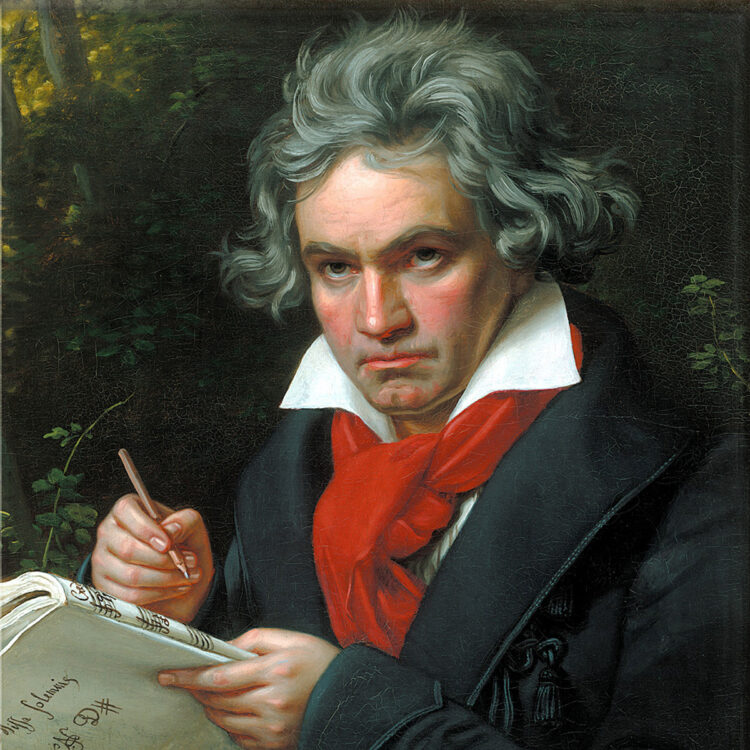Overture, The Consecration of the House
Ludwig van Beethoven was baptized in Bonn, Germany, on December 17, 1770, and died in Vienna on March 26, 1827. He composed his Consecration of the House Overture in 1822 for the reopening of the Josefstadt Theater, Vienna, which took place on October 3, 1822.
The score of the overture calls for 2 flutes, 2 oboes, 2 clarinets, and 2 bassoons; 4 horns, 2 trumpets, 3 trombones (only in the opening march), timpani, and strings (violins I and II, violas, cellos, double basses). The piece is about 12 minutes long.
Though the piece is heard somewhat infrequently today, the brilliance of Ludwig van Beethoven’s Consecration of the House Overture has made it singularly appropriate for new—and in this week’s case, revitalized—ventures. The overture was the first work performed by the BSO to open the orchestra’s very first subscription program in October 1881 under Georg Henschel’s direction, and he programmed the piece again as guest conductor for the first program of the BSO’s fiftieth season in October 1930. William Steinberg chose it to open his first program as music director in the fall of 1969, and Seiji Ozawa led it to mark the orchestra’s centennial in 1981. Andris Nelsons led the overture for the BSO’s return to live performances at Symphony Hall following the pandemic-altered 2019-2020 season.
It was for the inauguration of a newly rebuilt theater—the Josefstadt Theater in the Viennese suburbs—on October 3, 1822, that Beethoven composed this piece. The commission came at short notice from the theater’s manager, Beethoven’s old acquaintance Carl Friedrich Hensler. The play chosen to open the theater was a reworking by Karl Meisl of August von Kotzebue’s The Ruins of Athens, for which Beethoven had written incidental music in 1811. For the Joseftadt opening, the play’s reworked text was called Die Weihe des Hauses (The Consecration of the House). The words to several of Beethoven’s original musical numbers were modified, and Beethoven provided two new ones: a “chorus of dervishes,” and the present celebratory overture, delivered only the day before the opening.
Beethoven’s friend and biographer Anton Schindler wrote in his memoirs that Beethoven here took the opportunity to fulfill his long-cherished idea of writing an overture in the style of George Frideric Handel (1685-1759), who, together with Wolfgang Mozart and J.S. Bach, was high in Beethoven’s pantheon. Late in his life Beethoven was heard to describe Handel as “the greatest composer that ever lived,” and a forty-volume edition of Handel’s works was one of his most cherished possessions.
It is in the quick-moving fugal section of this overture that commentators hear Beethoven’s debt to Handel’s style. The work as a whole is in the general form of the Baroque “French overture,” which uses a stately, slow introduction, typically characterized by dotted rhythms, to introduce a main section in imitative style. Beethoven initiates the proceedings with a solemn processional. The sense of ceremony is heightened by the presence of trombones (still a rarity in orchestral music of the day), which fall silent once this opening music gives way to enlivening trumpet-and-drum fanfares. To these, the bassoons add scurrying sixteenth-note counterpoint. Strings and then winds take up the sixteenth-note activity, leading to a further heightening of energy. This outburst subsides into a brief oasis of calm, after which motivic fragmentation and then a quickening of pace lead in the main body of the piece—the fugal Allegro con brio, with its dizzyingly inventive treatment of the main theme’s comings, goings, and overlappings. From beginning to end of its twelve-minute course, the overture is music that never fails to startle, delight, and amaze.
The overture Consecration of the House is one of just three large orchestral works composed by Beethoven during his final decade, the other two being the Missa Solemnis and the Ninth Symphony. In manner, ethos, and affect, the overture reflects much that was visionary and new in Beethoven’s approach to composition at that time. Its importance to the composer was doubtless reflected in his choosing it to open what Maynard Solomon calls “the greatest public event of this period of his career”: his Vienna benefit concert of May 7, 1824, which also included the Kyrie, Credo, and Agnus Dei of the Missa Solemnis, and the first performance of the Ninth Symphony.
Steven Ledbetter
Steven Ledbetter, a freelance writer and lecturer on music, was program annotator of the Boston Symphony Orchestra from 1979 to 1998.
The first American performance of the Consecration of the House Overture was given in Boston by Carl Zerrahn and the Philharmonic Society on March 2, 1860.
The first Boston Symphony performance of the Consecration of the House Overture was led by Georg Henschel to open the orchestra’s inaugural season on October 22, 1881.

